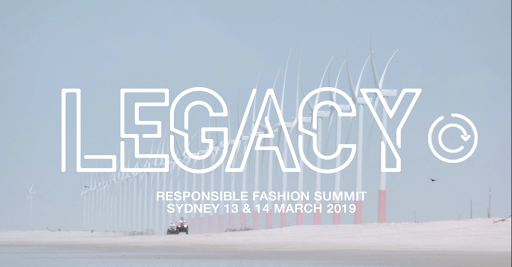ANTONIA HORLICK WRITES — At the beginning of March, Ndless: The New Normal, an ethical sourcing and sustainable supply chain fashion consultancy agency, hosted Australia’s first ‘sustainable” fashion summit: Legacy Responsible Fashion. This was done in partnership with The Australian Fashion Council and Fashion Revolution Australia.
The Legacy summit included topics such as: responsible material sourcing, sustainable fibers, worker empowerment, climate change, decarbonizing supply chains, circular economy designed with circularity, and best practice ethical sourcing programmes…and much more. The topic of a circular economy designed with circularity was a particularly crucial one. Circular design challenges a generation of products and materials in a way that minimizes the primary raw material use. The focus of circular design is on curtailing a value loss embedded in materials and products, by keeping them circulating in closed loops. These loops, such as reuse, repair, remanufacture, refurbishment or recycling, extend the product’s life cycle and improve resource productivity–something that is much needed in the current fashion economy.
The Summit not only brought together experts from the apparel industry but was also open to the public enabling rank-and-file members of the community to participate in the conversations about social and environmental issues in fashion.
On the first day, Eliza Ward, Senior Manager at Ethical Trading Initiative, London, spoke about the need for retailers and brands to promote better, safer working conditions for garment workers. The event took place at the perfect time— the fashion industry has recently become the world’s second largest polluter, after the oil industry. The apparel business accounts for 10% of global carbon emissions, with more than 150 billion garments produced annually; that’s enough to provide 20 new garments to every person on the planet, each year.
Environmental challenges facing the industry are vast, due largely to the rise in so-called “fast fashion: mass-produced cheap, disposable clothing that yields a tremendous amount of waste and pollution, not to mention the detrimental effects to which garment workers are exposed.
This continuous production of cheap garments is desirable in just one way—it reduces production costs. But water pollution from the apparel industry is contaminating the oceans, rivers, and lakes of the world with toxic chemicals that can kill humans and destroy the natural habitats of aquatic animals.
In addition, there are social costs to workers, often women, who labor under horrific conditions, in sweatshops, for very low wages. The Guardian notes, “many [female] workers [in India] who work toil long hours in an attempt to support their families on poverty wages [and] claim they are cheated out of their dues by their employers.”
The result of all this? According to Sustain Your Style, Americans now have 5 times more clothes than our grandparents. The rise of lower-cost brands like Topshop and Zara have increased consumer purchasing power. And in fact, Topshop has been involved in scandals dating back more than ten years. In 2012, it was revealed that the store had been hiring immigrant laborers who were working in potentially life-threatening conditions in a factory in the East-End of London. The CEO, Sir Philip Green, was accused of keeping cost down in order to boost his billion-dollar empire, through giving minimal pay to workers from Sri Lanka, India, and Bangladesh. So much for preventing human rights abuses, water, and air pollution, habitat destruction, and resource depletion.

Australia’s call for change pointed to the lack of awareness that retail companies have about the sustainable fashion model and how to conduct responsible material sourcing. Melinda Tually, who runs Fashion Revolution in Australia and New Zealand, told Vogue that “We can no longer relegate change to a small number of committed brands and business leaders who are carrying the burden of progress…”

Other countries have taken note. During this year’s fashion month, sustainable fashion was a key theme amongst designers, especially at London and Paris Fashion Week. Stella McCartney, known to be a strong advocate for sustainable fashion who uses only vegan materials in her collections, dedicated her Autumn/ Winter ‘19/ ‘20 show in Paris to forest protectors Canopy Planet.

Designers like Stella McCartney and companies like Ndless: The New Normal, Fashion Revolution Australia, and The Australian Fashion Council are bringing public attention to the sustainability cause. With an upsurge of intelligent consumers who want transparency, designers are motivated to invest in their brands’ identities and values. The first Legacy Responsible Fashion Summit, thrown in Sydney, Australia, ultimately promoted the idea that change is possible with new technologies, business models and initiatives developed by leading players in favor of waste-free design, fiber tracing, and worker empowerment.
Let’s hope the Legacy Summit expands globally. We like our clothes, yes; but we also like—and believe in—the need for environmental consciousness.

